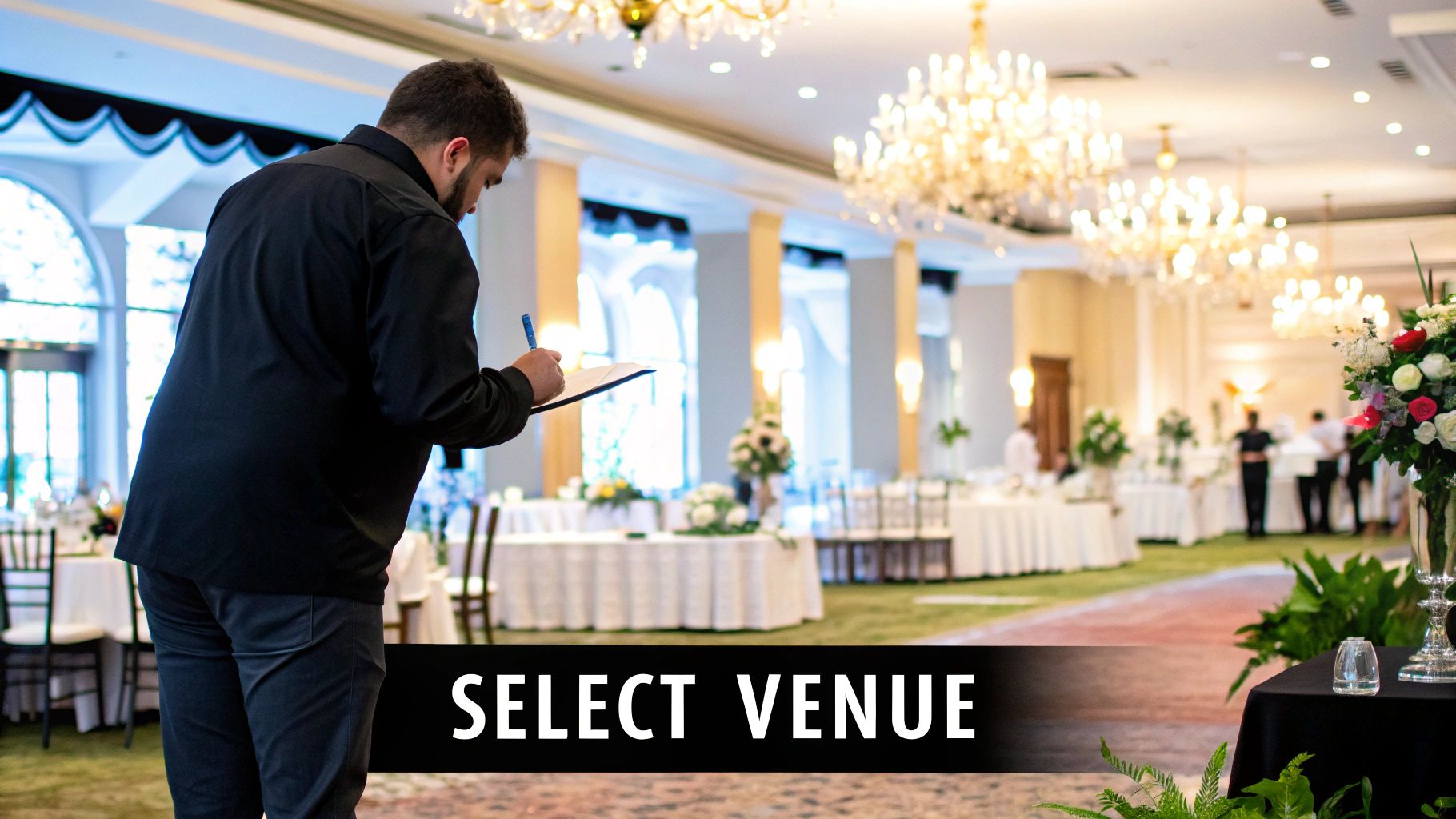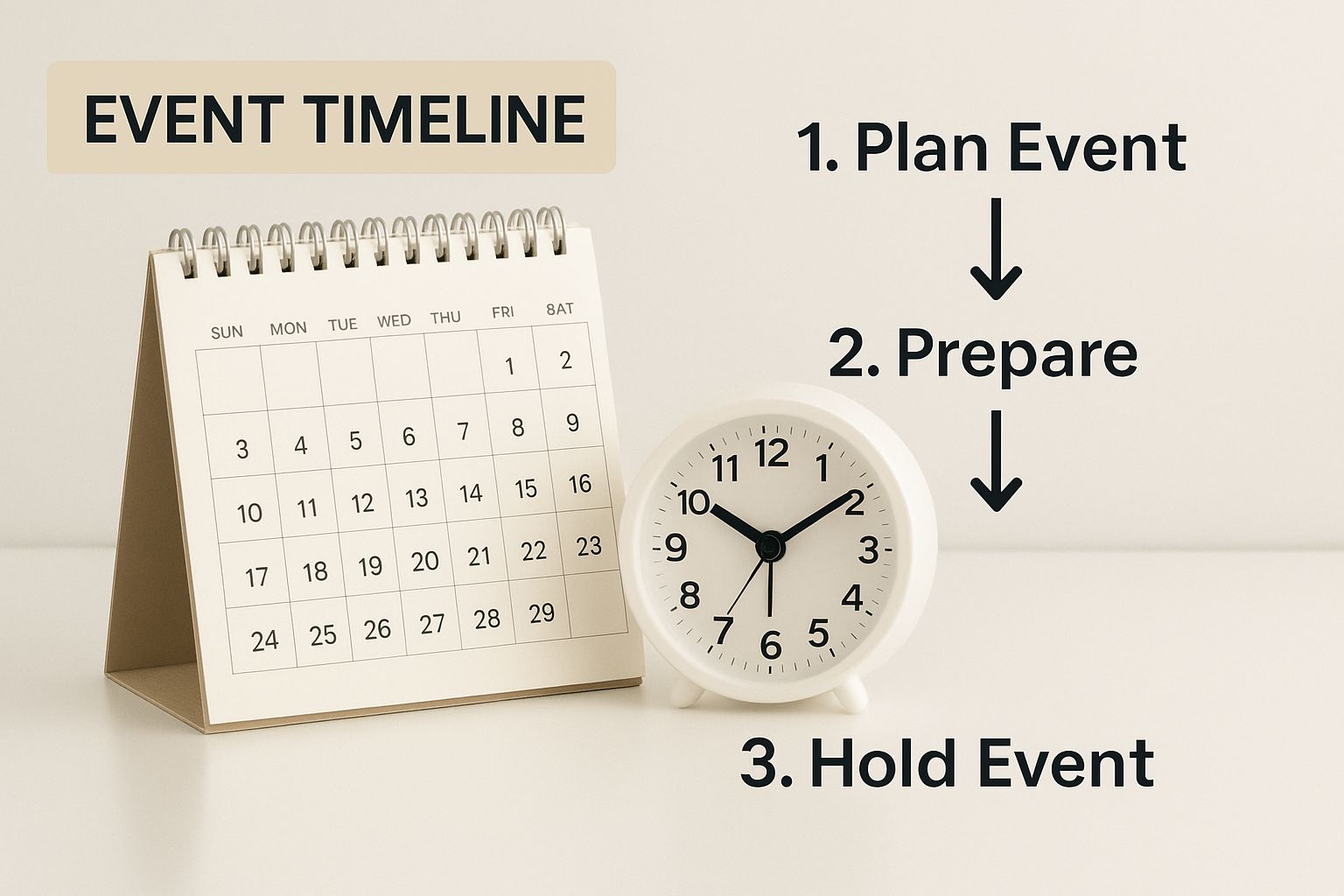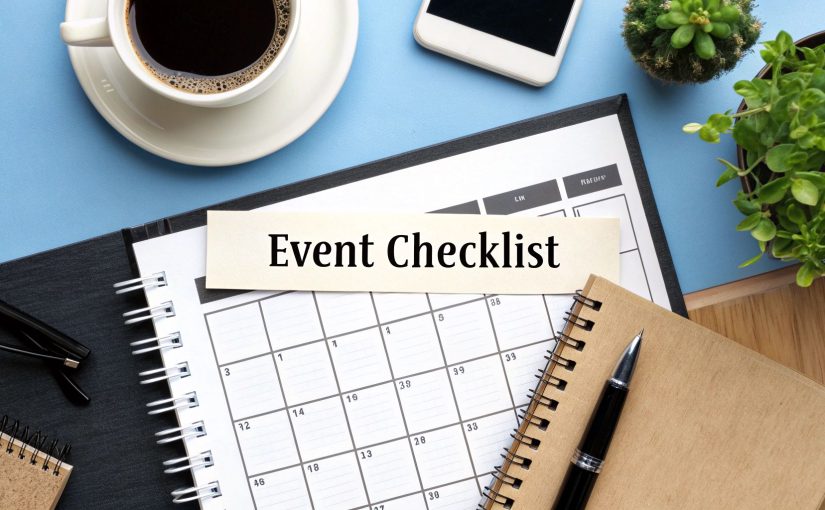I've seen my fair share of events, from intimate workshops to massive corporate conferences, and I can tell you one thing for sure: the success of any event hinges on what happens long before the doors open. That's where an event planning checklist template comes in. It's not just a to-do list; it’s the strategic backbone of your entire project, a dynamic roadmap that guides you from that first spark of an idea to the final post-event debrief.
Why Your Checklist Is Your Most Valuable Tool

Let's get past the obvious. Of course, a checklist helps you stay organised. But a truly professional event planning checklist is so much more. It's your best tool for managing risks, keeping stakeholders happy, and ensuring every single detail meets the high standard you've set. It becomes the central document that bridges the gap between your vision and the on-the-ground reality, especially when you're juggling multiple suppliers and last-minute changes.
Think of it as your single source of truth. The moment a client calls for a progress update or a supplier needs a deadline confirmed, your checklist has the answer. That immediate, confident response is what really separates the amateurs from the pros.
More Than Just Ticking Boxes
A great checklist isn’t about just ticking off tasks. It's about building a repeatable framework for success. Instead of starting from scratch every single time, you begin with a proven structure that already anticipates common problems and critical deadlines. This doesn’t just save you hours of work; it drastically cuts down on stress.
A professional checklist is your best defence against the inherent chaos of event management. It shifts your role from a reactive problem-solver to a proactive planner, freeing you up to focus on creating an unforgettable experience instead of constantly putting out fires.
This kind of framework is absolutely essential in a market that's always evolving. Take the event services sector in South Africa, for example. It has had to adapt rapidly, blending virtual and hybrid formats with traditional live events. A flexible event planning checklist allows organisers to pivot smoothly, whether they're planning a corporate indaba in Cape Town or a virtual trade show with a national reach. You can dig deeper into these shifts in the South African event services market on markwideresearch.com.
The Strategic Advantages of a Template
Using a template gives you a real strategic edge that goes way beyond simple organisation. It provides a clear, logical structure that helps you:
- Mitigate Risks: When you've mapped out every dependency—from locking in the venue to finalising the AV checks—you can spot potential roadblocks long before they become full-blown emergencies.
- Manage Expectations: A detailed checklist lets you share clear timelines and responsibilities with clients, suppliers, and your own team. No more confusion, everyone is on the same page from day one.
- Improve Consistency: It ensures you deliver the same high standard of quality for every event you manage, which is how you build a rock-solid reputation for excellence and reliability.
Ultimately, this isn't about being a slave to a list. It’s about having a system that is both robust and flexible—a system that supports your creativity and ensures your events are memorable for all the right reasons.
Building Your Event's Foundation

Every truly great event is built on a rock-solid plan. This first phase is all about making the big-picture decisions that will steer every other choice you make down the line. It's where you turn a vague idea into a clear, actionable strategy before the smaller details start clamouring for your attention.
The first thing you’ll tackle with your event planning checklist template is defining the core purpose of your event. Go deeper than just "sell tickets" or "have a party." What does success actually look like for you and your key stakeholders?
Defining Your Core Objectives
This is where you need to ask the big "why" questions. Is the main goal to generate new leads, boost brand awareness, lift employee morale, or celebrate a personal milestone? A corporate product launch in Sandton has completely different objectives than a wedding in the Cape Winelands, and your checklist needs to reflect that right from the start.
Getting crystal clear on your purpose allows you to set measurable Key Performance Indicators (KPIs). For instance:
- A corporate conference? Your goal might be to secure 50 qualified sales leads.
- A charity gala? You'll be aiming to raise R250,000 for the chosen cause.
- A brand activation? Success could be measured by achieving 100,000 social media impressions with the event hashtag.
Once these goals are set in stone, every decision that follows—from the venue to the catering—can be weighed against them. This keeps your event laser-focused and ensures it delivers real, tangible results. For a detailed look at how these early decisions play out for a specific event type, you can learn more about the essentials of planning a wedding in our guide.
Setting a Realistic Budget and Timeline
With your goals established, it's time to tackle what is often the most challenging part of planning: the budget. A good budget isn't just a list of expenses; it's your financial roadmap for the entire project.
Your checklist should push you to think about everything, especially the costs that are easy to forget. Don't just budget for the obvious big-ticket items like the venue and food. Make sure you've got line items for things like:
- Permits and licences
- Insurance coverage
- Marketing and promotion
- Staffing and security
- A contingency fund (always, always aim for 10-15% of your total budget)
A detailed budget is your best defence against scope creep and nasty financial surprises. Think of it as your primary tool for making smart, data-driven decisions every step of the way.
Hand-in-hand with budgeting is setting the date. You'll need to check for potential clashes with public holidays, school holidays, or other major industry events that could affect attendance. The perfect date is a sweet spot between maximising guest turnout and fitting with your top-choice venue and vendor availability.
Choosing the Perfect Venue
The venue sets the entire tone for your event. You could argue it's the single most important decision you'll make in this foundational stage. When you're out scouting potential locations, your checklist becomes an indispensable companion for the site visit.
As you walk through a space, look past the aesthetics and get practical. Is there enough parking? What are the accessibility options like for guests with mobility issues? Critically, does the venue have exclusive supplier contracts that could lock you into using their caterer or AV team?
Pay very close attention to what's included in the rental fee. Some venues provide tables, chairs, and basic linens, while others are a complete blank slate, leaving you to hire everything. Knowing this upfront is vital for your budget. Also, be sure to ask about their policies on setup and tear-down times to make sure your schedule is even feasible. Nailing down a contract that clearly outlines all these details is non-negotiable—it protects your investment and saves a world of last-minute stress.
Managing Vendors and Marketing Your Event
Alright, you’ve laid the groundwork. Now comes the exciting part: bringing all the pieces together to create a living, breathing event. This is where you'll focus on two critical fronts at once – lining up your expert vendors and getting the word out to your future attendees. Think of it as a two-pronged attack: one behind the scenes, getting your suppliers perfectly in sync, and the other facing the public, building a buzz that’s impossible to ignore.
Your checklist is your command centre for this phase. It helps you manage all the moving parts, from the caterers and florists to the sound and lighting crew, while also keeping your marketing efforts on a clear timeline.
This visual timeline gives you a great bird's-eye view of how these crucial stages fit together.

As you can see, vendor management and marketing aren't sequential; they happen in tandem. Juggling both effectively is what separates a good event from a truly great one.
Finding and Managing Your Dream Team of Vendors
The people you hire to execute your vision can make or break your event. They’re more than just suppliers; they’re your partners in creating an experience. So, finding the right ones is non-negotiable.
Your checklist should be your guide here. Start by researching and creating a shortlist. I always recommend getting at least three quotes for any major service. It gives you a feel for the market and ensures you’re getting fair value.
When you make contact, go deeper than just the price. Ask to see their portfolio, but specifically for events similar in style and scale to yours. A fantastic wedding DJ might not have the right vibe for a corporate awards night. Always, always ask for references you can actually speak to.
Once you’ve narrowed it down, get them on the phone. This is your chance to see if you click. You’ll be working with these people under pressure, so a good rapport and clear communication are essential.
Here are a few hard-won tips I’ve learned over the years:
- No Contract, No Deal: This is a golden rule. A signed contract protects everyone and should clearly detail every service, all costs, payment dates, and the cancellation policy. Don't proceed without one.
- Keep Communication Central: Create a section in your checklist for each vendor with all their contact info, contract deadlines, and payment reminders. It saves a world of headaches later on.
- Hold a Final Walk-Through: A week or two before the event, get all your key vendors on a call or, if possible, on-site. Run through the entire event timeline from start to finish so everyone knows their cues.
Don't be afraid to think outside the box to give your guests something special. For instance, have you ever considered learning more about hiring a mobile bar service? It can add a really memorable and sophisticated touch to almost any function.
To help you stay on track, here's a quick reference table for the vendor management process.
Vendor Selection and Management Checklist
This table guides you through the key steps of selecting and managing event vendors effectively.
| Task | Key Considerations | Checklist Item |
|---|---|---|
| Initial Research | Identify potential vendors through online searches, referrals, and industry networks. | Shortlist at least 3 vendors per category. |
| Vetting | Review portfolios, check references, and verify insurance and licenses. | Request and review work from similar events. |
| Contracts | Ensure all terms, services, and costs are clearly documented. | Sign a detailed contract before any work begins. |
| Communication | Establish a primary point of contact and a clear communication plan. | Add all vendor details to your master checklist. |
| Final Briefing | Coordinate a pre-event meeting to confirm final details and timelines. | Schedule a final run-through 1-2 weeks out. |
Following these steps will help ensure your team of vendors is professional, reliable, and perfectly aligned with your event's vision.
Crafting a Simple and Effective Marketing Plan
You could plan the most incredible event ever, but if no one shows up, it’s just a beautifully decorated empty room. This is why your marketing can’t be an afterthought. It’s what fills those seats.
You don't need a massive, complex strategy. You just need a thoughtful one.
Start with a simple, clean landing page or a dedicated section on your website. This is your information hub. It needs the agenda, speaker bios, venue details, and, most critically, a big, obvious button to register or buy tickets. A huge portion of your audience will see this on their phones, so make absolutely sure it’s mobile-friendly.
When you write your marketing copy, always frame it from the attendee's perspective. Don't just list what your event has; explain what your guests will get. Will they gain new skills, meet influential people, or just have an unforgettable night out? Focus on the benefit.
Now, use your checklist to sketch out a marketing timeline. A few key activities should be on there:
- Early-Bird Special: Launch your tickets with a limited-time discount. It creates a sense of urgency and helps secure those crucial first registrations, which builds momentum.
- Social Media Buzz: Figure out which platforms your target audience actually uses and be there. Plan out your content – things like speaker spotlights, behind-the-scenes peeks as you plan, and countdown posts work really well.
- Email Campaign: If you have an email list, use it! Send regular updates to keep your event top-of-mind. Announce new speakers, share exciting programme details, and send friendly reminders before deadlines.
Consistency is everything. From your very first "save the date" post to the final "what you need to know" email, every communication should build excitement and make your guests feel like they're in good hands.
Bringing It All Together: Final Pre-Event Logistics
The final few weeks before an event are where the real magic happens. This is the home stretch, where all your careful planning comes to life. Your event planning checklist template stops being a "what-if" document and becomes your minute-by-minute playbook for success. Getting this final countdown right is what separates a good event from a truly unforgettable one.
First things first: nail down the final run-of-show. This is more than just a schedule; think of it as the complete script for the day. It needs to account for every single moment, from the first supplier pulling up to the venue, right through to the last guest heading home. It should also include precise cues for speakers, entertainers, and your catering team.
The Last (and Most Important) Venue Walkthrough
About one to two weeks out, you need to get back to the venue for one last walkthrough with all your key players. This isn't just a casual glance around. It’s a full-on logistical dress rehearsal. Bring your checklist and be ready to tick off every single detail you’ve planned.
Here’s what you need to focus on during this visit:
- Confirm Layouts: Physically walk through the space. Does the seating arrangement feel right? Is the stage placed for the best visibility? Where, exactly, will the registration desk go?
- Test All AV Equipment: Don't just look at it. Get your AV technician to fire up the microphones, projectors, and lighting. Glitches with tech are incredibly common on the day, so testing everything beforehand is an absolute must.
- Check Power and Wi-Fi: Map out every power outlet you'll need and test the Wi-Fi signal strength. This is crucial if you’re planning on live-streaming or need reliable connectivity for your guests.
This walkthrough is also your golden opportunity to get face-to-face confirmation from every vendor. Make sure the caterer has the final headcount and is clear on service times. If they're serving hot food, double-check their setup needs. You can find some great advice on the best practices for catering food warmers to make sure that side of things is flawless. Lock in delivery times with your furniture hire company and do a final run-through of the timeline with your entertainment.
You should walk away from this final meeting with absolutely no unanswered questions. Every supplier needs to know exactly where to be, what to do, and when to do it.
Briefing Your On-Site Team
Your staff and volunteers are the hands and feet of your event—they're the ones interacting with your guests. A well-briefed team can troubleshoot on the fly and ensure everything feels smooth and effortless. An unprepared team, however, can quickly lead to confusion and chaos.
Schedule a proper pre-event briefing. Give every single person a copy of the run-of-show, a clear venue map (with key spots like bathrooms and first aid marked), and a contact list for all the event leads. Take the time to clearly explain their roles and what you expect from them. I find it really helps to run through a few "what-if" scenarios, like "What do you do if a guest feels unwell?" or "Who do you call if a speaker is running late?"
Always Have a Plan B
Let's be honest: even with the most detailed checklist in the world, things can go sideways. A keynote speaker gets stuck in traffic, a freak thunderstorm rolls in during your garden party, or the venue’s Wi-Fi decides to take a break. This is precisely why a solid contingency plan is your best friend.
Your checklist should have a whole section dedicated to this. For every critical part of your event, ask yourself, "What's my backup?"
- Keynote Speaker: Have a co-presenter ready to step in or a backup presentation cued up.
- Outdoor Venue: Know your rain plan inside and out. What's the final call time to move everything indoors?
- Technology: Pack a bag with backup chargers, every conceivable adaptor, and have the mobile number for an on-call IT person handy.
Thinking through potential problems isn't pessimistic; it's professional. It's the final piece of the puzzle that allows you to handle any curveball with grace and keep your event running like a well-oiled machine, no matter what.
Flawless Execution and Post-Event Success
The doors are open, the music’s playing, and your vision is finally a reality. On the day of the event, your role shifts dramatically from planner to conductor. That event planning checklist template you've spent so much time on? It’s now your on-site command sheet, guiding the flow of the day and making sure every single detail lands perfectly.
This is exactly where all that meticulous preparation pays off. You'll lean on your checklist to manage the check-in process, keeping registration lines moving smoothly to create a fantastic first impression. It's also your go-to for troubleshooting in real-time. If the AV technician hits a snag or a caterer is running five minutes late, your checklist has their contact details and the agreed-upon timeline right at your fingertips.
Mastering On-Site Coordination
Being effective on-site is all about being present and proactive. My advice is to constantly walk the floor. Check in with your team, your vendors, and even your guests. This kind of visibility lets you spot potential hiccups long before they have a chance to turn into actual problems.
Here are a few practical tasks that should be on your day-of checklist:
- Final Sound and Light Checks: Just before guests start arriving, do one last run-through to ensure the ambiance is exactly what you envisioned.
- Catering Coordination: Touch base with the catering manager to confirm meal service times and make sure they're perfectly aligned with your run-of-show.
- Speaker Management: Greet speakers the moment they arrive, show them to the green room, and do a final check of their presentation materials.
And don't forget the budget. A recent study found that 74% of event planners say staying on budget is their biggest challenge, and on-site is where unforeseen costs love to appear. I always keep a dedicated section in my checklist just for tracking any last-minute expenses. This creates a clear record for my final budget reconciliation and stops small, unapproved charges from derailing our financial success.
The Crucial Post-Event Wrap-Up
Just because the last guest has left doesn't mean your work is done. The post-event phase is arguably just as important as the planning itself. It’s where you truly measure success, strengthen relationships, and lay the groundwork for whatever comes next. Your checklist is your guide through this final, critical stage.
Start with the immediate logistics. Organise your breakdown and clean-up crew to ensure the venue is returned to its original condition. You'll also need to oversee the return of all hired equipment and settle any outstanding balances with your vendors as soon as possible. Paying suppliers quickly is one of the best ways I've found to build a strong, reliable network for future events.
The days immediately following an event are your golden window for feedback. Don't let it close. Capturing attendee thoughts while the experience is still fresh is the single best way to measure your impact and demonstrate a clear return on investment to stakeholders.
Get a simple feedback survey out the door within 24 hours. Ask pointed questions about what they loved, what could be improved, and whether the event met their expectations. This data is pure gold. It’s not just for a report; it’s your roadmap for making the next event even better.
Finally, never underestimate the power of a personal touch. Send customised thank-you notes to your speakers, sponsors, and key partners. It’s a simple gesture, but it goes an incredibly long way in nurturing those vital professional relationships.
Got Questions? Let's Talk Event Planning
Even the most comprehensive checklist can't cover every single scenario. Questions are bound to come up, and that's a good thing! Getting answers early helps you tweak your plan and avoid the common pitfalls that even seasoned pros run into.
Your checklist is your starting point, not a rigid rulebook. It's meant to be pulled apart, customised, and made your own.
How Far Out Should I Start Planning?
Honestly, this all comes down to the size and complexity of your event. For a big affair like a conference or a wedding, I always suggest a lead time of 9-12 months. That buffer is crucial for locking in the best venues and suppliers before they get booked up.
If you're organising a smaller corporate meeting, a product launch, or a workshop, you can usually get away with a 3-6 month planning window.
My go-to trick is to work backwards from the event date. Once you slot in the non-negotiable deadlines—like finalising the venue or signing off on catering—your entire timeline starts to take shape and feel much more manageable.
How Do I Make This Template Work for My Specific Event?
The very first thing I do is a quick "relevancy check." For instance, if I'm planning a virtual summit, I'll immediately axe anything related to physical venue logistics, on-site catering, or travel arrangements. It’s a simple way to clear the clutter.
Then, you can start adding the tasks that are unique to your event. This could be anything from "Book Virtual Platform Partner" for a webinar to "Test Speaker A/V Connections" before a hybrid conference. Don't be shy about adding, deleting, or shuffling tasks until the checklist feels like it was built just for you.
From my own experience, the one thing almost everyone forgets is proper contingency planning. It’s easy to get caught up in planning the perfect day, but we also have to prepare for what might go wrong.
This means having a backup for your keynote speaker, a solid rain plan for an outdoor function, or a simple troubleshooting guide for your tech. Another often-missed step is the post-event debrief. We're all so relieved when it's over that we forget to collect feedback, which is the only way to prove your event's value and make the next one even better.
Ready to bring your event vision to life with the perfect furniture and equipment? ABC Hire offers everything you need, from stylish seating to climate control, to make your event unforgettable. Explore our extensive rental collection at https://abchire.co.za.

